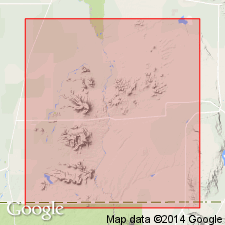
- Usage in publication:
-
- Manassa Member
- Modifications:
-
- Named
- Dominant lithology:
-
- Breccia
- Lava
- AAPG geologic province:
-
- San Luis basin
Summary:
Named as the upper (of 3) member of Conejos formation for exposures throughout western San Luis Hills east of Manassa, Conejos Co, CO in the San Luis basin. No type locality designated. Overlies the newly named La Sauses Member of Conejos unconformably. Composed of basaltic-appearing explosive breccias, flow breccias, and lava flows. The 800 ft thick section of highly oxidized dark-red scoria with fine tuffaceous binding material present along southeast side of Mesa de La Sauses grades laterally and vertically into flow breccias and lava flows along north side of mesa; this is the most extensive pile of scoriaceous material in San Luis Hills. Petrographically the lower and upper parts of member are basaltic-appearing andesites. Beneath upper flows, pyroclastic breccias, flow breccias, and lava flows are characterized by plagioclase phenocrysts 1-5 mm long and a general absence of olivine, and a presence of biotite. All parts have fresh magnetite. Augite and orthopyroxene are present throughout section. Apatite and quartz recognized locally. Has maximum thickness of about 1,500 ft. Geologic map. K-Ar dates of 27.4 +/-0.6 and 27.9 +/-0.6 m.y. have been obtained from a stock that intrudes the Manassa. Overlain by Servilleta Formation. Oligocene age.
Source: GNU records (USGS DDS-6; Denver GNULEX).
For more information, please contact Nancy Stamm, Geologic Names Committee Secretary.
Asterisk (*) indicates published by U.S. Geological Survey authors.
"No current usage" (†) implies that a name has been abandoned or has fallen into disuse. Former usage and, if known, replacement name given in parentheses ( ).
Slash (/) indicates name conflicts with nomenclatural guidelines (CSN, 1933; ACSN, 1961, 1970; NACSN, 1983, 2005, 2021). May be explained within brackets ([ ]).

